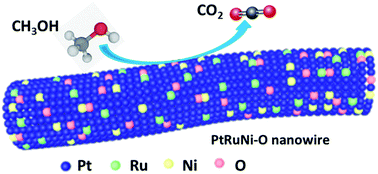Surface oxygen-mediated ultrathin PtRuM (Ni, Fe, and Co) nanowires boosting methanol oxidation reaction†
Abstract
Improving the electrocatalytic activity and durability of electrocatalysts is of vital importance to the direct methanol fuel cells. PtRu materials are the most effective catalysts for methanol oxidation reaction (MOR) in an acidic medium, but they still exhibits partial defects, such as limited catalytic activity. Here, we prepared a series of surface oxygen-mediated ultrathin PtRuM (M = Ni, Fe, and Co) nanowires (NWs) termed PtRuM–O. All these prepared materials showed ultrahigh electrocatalytic activity and excellent durability for MOR in an acidic medium due to their optimal electronic structures induced by the introduction of electroactive O. Until now, in the reported article on Pt-based materials, the optimal Pt62Ru18Ni20–O/C electrocatalyst shows the highest mass activity of 2.72 A mgPt−1 for MOR in an acidic medium, which is 1.42, 5.14 and 9 times higher than that of Pt62Ru18Ni20/C (1.91 A mgPt−1), Pt65Ru35/C (0.47 A mgPt−1), and Pt/C (0.30 A mgPt−1) NWs catalysts, respectively. Also, the Pt62Ru18Ni20–O/C catalyst still retains 92% of its initial mass activity after 1000 voltammetry (CV) cycles. The CO stripping experiment results revealed that the peak potential of Pt62Ru18Ni20–O/C shows a negative shift compared with that of Pt62Ru18Ni20/C, Pt65Ru35/C, and Pt/C NWs catalysts, indicating that the Pt62Ru18Ni20–O/C catalyst has the best CO anti-poisoning. The as-prepared electrocatalysts also showed better MOR performance in an alkaline medium. The density functional theory (DFT) calculations proved that the introduction of O to PtRuNi significantly boosts the MOR performance by strengthening the adsorption of initial CH3OH induced by the electroactive O-2p bands. Moreover, a much larger energy barrier for CO generation indicates the much lower probability of the catalyst poisoning of the PtRuNi–O.

- This article is part of the themed collection: Journal of Materials Chemistry A HOT Papers


 Please wait while we load your content...
Please wait while we load your content...